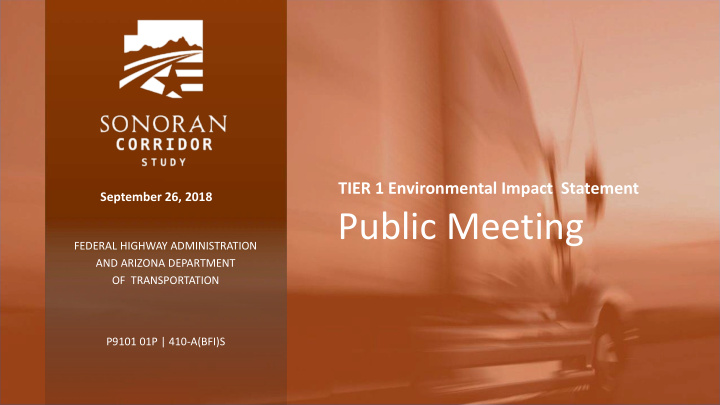



TIER 1 Environmental Impact Statement September 26, 2018 Public Meeting FEDERAL HIGHWAY ADMINISTRATION AND ARIZONA DEPARTMENT OF TRANSPORTATION P9101 01P | 410-A(BFI)S
Title VI TITLE VI OF THE CIVIL RIGHTS ACT OF 1964 AND THE AMERICANS WITH DISABILITIES ACT (ADA) Pursuant to Title VI of the Civil Rights Act of 1964 and the Americans with Disabilities Act (ADA), ADOT does not discriminate on the basis of race, color, national origin, age, sex or disability. Persons who require a reasonable accommodation based on language or disability should contact Joanna Bradley at 520.235.3494 or at JBradley@azdot.gov. Requests should be made as early as possible to ensure the State has an opportunity to address the accommodation. De acuerdo con el título VI de la Ley de Derechos Civiles de 1964 y la Ley de Estadounidenses con Discapacidades (ADA por sus siglas en inglés), el Departamento de Transporte de Arizona (ADOT por sus siglas en inglés) no discrimina por raza, color, nacionalidad, edad, género o discapacidad. Personas que requieren asistencia (dentro de lo razonable) ya sea por el idioma o por discapacidad deben ponerse contacto con Joanna Bradley al 520.235.3494 o JBradley@azdot.gov. Las solicitudes deben hacerse lo más pronto posible para asegurar que el equipo encargado del proyecto tenga la oportunidad de hacer los arreglos necesarios.
Welcome Overview Need and Purpose Overview Evaluation Methodology Review Development of Corridor Alternatives • Engineering Requirements • Corridor Connections Refinement Study Process Status Next Steps
Study Area The Sonoran Corridor was designated by Congress in the FAST Act as a high priority corridor connecting I-19 to I-10, south of Tucson International Airport
Sonoran Corridor Study Status We are here
Need and Purpose Purpose Need Accommodate future travel demand Projected substantial population and Provide alternate direct connection employment growth in the corridor between I-10 and I-19 south of TIA to Additional system linkages for regional reduce commercial and commuter and interstate mobility travel times and cost Reduced congestion and increased Improve 2045 Level of Service within roadway capacity study area
Evaluation Categories Anticipated Growth Mobility System Linkages Economic Benefit Environment Constructability
Tiered Environmental Review Process Tier 2 Environmental Studies Tier 1 EIS Advance Tier 1 Recommendations Establish Need and Purpose Project specific studies and alignments Corridor evaluation and recommendation Preliminary engineering and specific Program for future implementation mitigation
Scoping Process Public information scoping meetings allowed stakeholders to provide comments on the project’s need, opportunities, and potential route locations Agency Scoping Meeting - June 7, 2017 Public Scoping Meetings - June 7, 2017 and June 8, 2017
Public Scoping More than 90 comments and questions received on comment forms and emails, by telephone and online between May 2017 and July 2017
Public Scoping Comments More than 90 public comments were received between May 12 and July 15, 2017 Key Points: Consider existing infrastructure Address traffic congestion and delays Concerns with increased commercial traffic vehicles Avoid negative effects on residential areas Concerns about noise and air pollution Concerns about the local environment/habitat
Corridor Identification - Public
Corridor Identification – Public (modified)
Agency Scoping Agency scoping meetings held May through July 2017 Forty representatives of 12 agencies participated during scoping phase Agency input led to three corridors now being evaluated
Agency Scoping Comments Key Points: Promote economic development opportunities Focus on movement of freight and commerce Reduce travel times for area commuters Consider a route that provides access to Tucson International Airport from the south Include multimodal and technology in selected corridor
Tribal Outreach Study area includes Tohono O’odham Nation (TON) - San Xavier District (SXD) Coordination with TON-SXD throughout project via community meetings Collaboration on transportation corridor on TON-SXD lands Coordination with landowners to assess preferences regarding corridors
Corridor Identification - Agencies
Development of Corridor Alternatives- Quantm Engineering and environmental inputs Systematic analysis for range of reasonable alternatives Route trends Density analysis for corridor alternatives
Corridor Identification - Quantm 28 Quantm Corridors
Comprehensive Set of Corridors 32 Total Routes
Engineering and Access Requirements Local mobility impacts Impact to local community institutions and features Roadway design guidelines for system interchanges Freeway-to-freeway interchange should be 2 miles from nearest local freeway interchange Access must be maintained at local interchanges if replaced by a freeway-to-freeway interchange
Optimized List of Alternatives 10 Corridors will be analyzed with the Evaluation Screening Criteria
Optimized Alternatives from San Xavier District 3 Corridors will be analyzed starting from the San Xavier District I-19 Interchange connecting to three I-10 Interchanges
Optimized Alternatives from Pima Mine Road 3 Corridors will be analyzed starting from the Pima Mine Road I-19 Interchange connecting to three I-10 Interchanges
Optimized Alternatives from El Toro South 3 Corridors will be analyzed starting from the El Toro South I-19 Interchange connecting to three I-10 Interchanges
Optimized Corridor Alternatives Alternative will be analyzed starting from the El Toro South I-19 Interchange connecting to the Wentworth Road Interchange on I-10
How to Comment Comment Form – available at this meeting Telephone: 1.855.712.8530 (Toll Free) Email: sonorancorridor@azdot.gov Mail: Sonoran Corridor Tier 1 EIS Study Team; c/o Joanna Bradley 1221 S. Second Ave., Mail Drop T100, Tucson, AZ 85713 Online: azdot.gov/sonorancorridor Comments encouraged by October 26, 2018
Key Milestones Timeline Need and Purpose – Completed January 2018 Evaluation Methodology – Completed July 2018 Comprehensive Set of Corridors – Completed July 2018 Refined List of Corridors – September 2018 Range of Reasonable Corridors – December 2018 Final Corridor Alternatives – January 2019 Corridor Selection Report – February 2019 Draft Tier 1 EIS – Summer 2019 Final Tier 1 EIS/ROD – Spring 2020
Next Steps Final Refined List of Optimized Corridors Screening Results – Reasonable Range of Alternatives – Late 2018 Public Meeting – January/February 2019 Corridor Selection Report – February 2019 Draft Tier EIS 2019 Public Hearings – Late 2019
Study Contacts TREMAINE WILSON CARLOS LOPEZ Environmental Coordinator Project Manager FHWA ADOT Multimodal Planning Division Tremaine.Wilson@dot.gov clopez@azdot.gov 602-382-8970 602-712-4786 EMAIL PROJECT WEBSITE sonorancorridor@azdot.gov azdot.gov/sonorancorridor
Recommend
More recommend